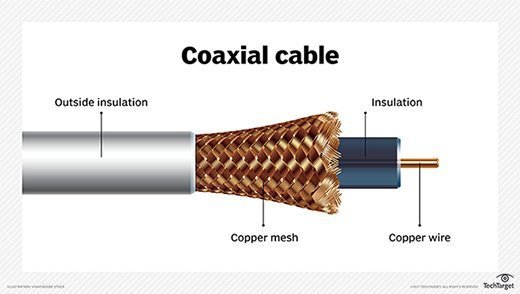What are the types of cable
The types of cable
A. Twisted Pair.
a cable consisting of two wires twisted around each other, used especially for telephone or computer applications.
a. STP ( Shielded Twisted Pair ) - Shielded twisted pair (STP) cable was originally designed by IBM for token ring networks that include two individual wires covered with a foil shielding, which prevents electromagnetic interference, thereby transporting data faster.
b. UTP ( Unshielded Twisted Pair ) Unshielded twisted pair (UTP) cables are widely used in the computer and telecommunications industry as Ethernet cables and telephone wires. In an UTP cable, conductors which form a single circuit are twisted around each other in order to cancel out electromagnetic interference (EMI) from external sources.
B. Coaxial
Coaxial cable is a type of copper cable specially built with a metal shield and other components engineered to block signal interference. It is primarily used by cable TV companies to connect their satellite antenna facilities to customer homes and businesses. It is also sometimes used by telephone companies to connect central offices to telephone poles near customers. Some homes and offices use coaxial cable, too, but its widespread use as an Ethernet connectivity medium in enterprises and data centers has been supplanted by the deployment of twisted pair cabling.
C. Fiber Optic
Fiber optic cable is a high-speed data transmission medium. It contains tiny glass or plastic filaments that carry light beams. Digital data is transmitted through the cable via rapid pulses of light.
Straight Through Cable
A straight through cable is a type of twisted pair cable that is used in local area networks to connect a computer to a network hub such as a router. This type of cable is also sometimes called a patch cable and is an alternative to wireless connections where one or more computers access a router through a wireless signal. On a straight through cable, the wired pins match. Straight through cable use one wiring standard: both ends use T568A wiring standard or both ends use T568B wiring standard. The following figure shows a straight through cable of which both ends are wired as the T568B standard.
An Ethernet crossover cable is a type of Ethernet cable used to connect computing devices together directly. Unlike straight through cable, crossover cables use two different wiring standards: one end uses the T568A wiring standard, and the other end uses the T568B wiring standard. The internal wiring of Ethernet crossover cables reverses the transmit and receive signals. It is most often used to connect two devices of the same type: e.g. two computers (via network interface controller) or two switches to each other.








 source:
source: 



